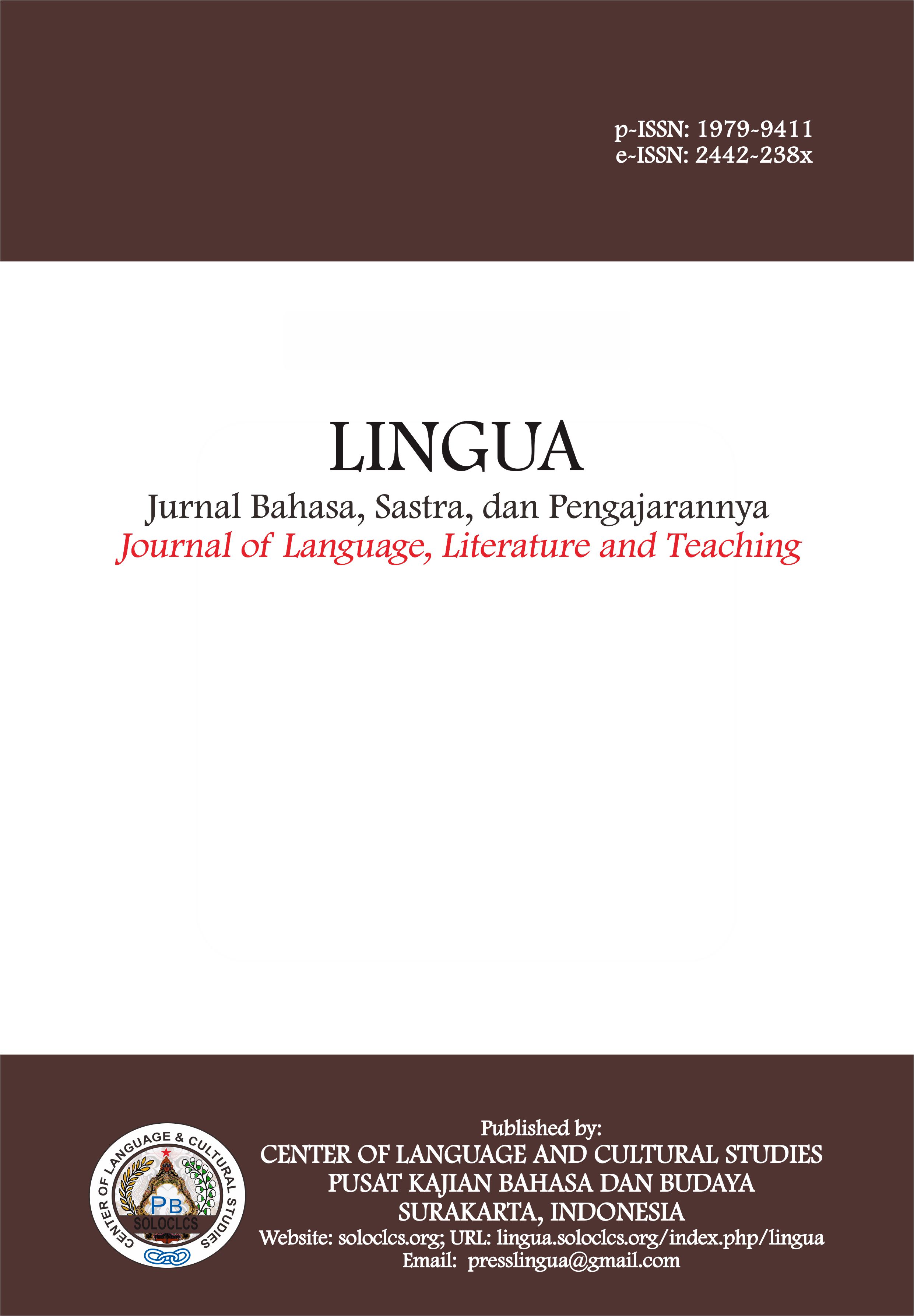Antara Nama dan Budaya Fonestemik, Onomatope, dan Kearifan Lokal dalam Penamaan Jajanan Tradisional di Jawa Timur – Kajian Antropolinguistik
DOI:
https://doi.org/10.30957/lingua.v22i1.1067Keywords:
Phonestemics, Onomatopoeia, East Java Cultural Snacks, Cultural ElementsAbstract
Snacks are specific forms of food that play an important role in people's lives and reflect local beliefs, culture and values. In Javanese society, the naming of traditional snacks is often associated with physical characteristics and sounds, so this research focuses on identifying the forms of naming traditional East Javanese snacks that contain phonestemic and onomatopoeic elements and their relationship with local culture. Furthermore, this study aims to describe the kinds of onomatopoeia, phonestemics and cultural elements to show the various forms underlying the diversity of Javanese language in the naming of traditional East Javanese snacks. The data sources of the research are reliable informants who can provide information about traditional East Javanese snacks, literature, and supporting documents. The research data was taken in December 2024 - February 2025. Data was collected using literature study, interview, and observation techniques. Furthermore, the data that has been classified is then analyzed using agih and padan methods. Using a qualitative descriptive approach, this study analyzed phonemically 55 traditional East Javanese snack names and found phonestemic elements in the form of (1) big and small nuances; (2) hard and soft nuances, as well as onomatopoeic elements consisting of (1) root words as basic words; (2) root words plus formatives; (3) root words doubled; (4) root reduplication; and (5) based on compound words. In addition to the naming of traditional East Javanese snacks being analyzed for its formation, the naming of these snacks is also based on various cultural influences that develop in the community and become local wisdom. The results show that the character of the formation of traditional East Javanese snack names is not only unique from its phonestemic and onomatopoeic naming, but also closely related to local wisdom and cultural identity of the local community.
Downloads
References
Achaya, K. T. (1998). A historical dictionary of Indian food. Oxford University Press. http://catdir.loc.gov/catdir/enhancements/fy0636/98903528-d.html
Ayu, A., & Baryadi, P. (2021). Dasar penamaan kue jajanan pasar di Pasar Lempuyangan Yogyakarta.
Jurnal Ilmiah Kebudayaan Sintesis, 15(1), 1–16. https://doi.org/10.24071/sin.v15i1.3123 DOI: https://doi.org/10.24071/sin.v15i1.3123
Bayu, E. Y. (2017). Ragam cerita kue cucur [WordPress]. Eveline Goes Holiday.
https://evelinegoesholiday.wordpress.com/2017/03/25/ragam-cerita-kue-cucur/
Brandstetter, R. (1957). (S. Djajadiningrat, Trans.). Akar kata dan kata dalam bahasa-bahasa Indonesia. PT Pustaka Rakyat.
Bredin, H. (1996). Onomatopoeia as a figure and a linguistic principle. New Literary History, 27(3), 555–569. https://doi.org/10.1353/nlh.1996.0031 DOI: https://doi.org/10.1353/nlh.1996.0031
Chaer, A. (2009). Pengantar semantik bahasa Indonesia. Jakarta: PT Rineka Cipta. Chaer, A. (2013). Pengantar semantik bahasa Indonesia. Jakarta: Rineka Cipta.
Christie, J. W. (1998). Javanese markets and the Asian sea trade boom of the tenth to thirteenth centuries A.D. Journal of the Economic and Social History of the Orient, 41(3), 344–381. JSTOR. DOI: https://doi.org/10.1163/1568520981436264
Danial, & Wasriah. (2009). Metode penulisan karya ilmiah. Laboratorium Pendidikan Kewarganegaraan UPI.
Djajasudarma, T. F. (2009). Semantik 2: Pemahaman ilmu makna. Bandung: Refika Aditama.
Eglin, P. (1980). Talk and taxonomy: A methodological comparison of ethnosemantics and ethnomethodology with reference to terms for Canadian doctors. John Benjamins Publishing Company. https://doi.org/10.1075/pb.i.8 DOI: https://doi.org/10.1075/pb.i.8
Giri, W. (2010). Sajen dan ritual orang Jawa. Yogyakarta: Narasi. Gonda, J. (1987). Rice and barley offerings in the Veda. E.J. Brill.
Hoogervorst, T. (2015). Detecting pre-modern lexical influence from South India in maritime Southeast Asia. Archipel, 89, 63–93. https://doi.org/10.4000/archipel.490 DOI: https://doi.org/10.4000/archipel.490
Islami, M. E. N., & Ikhsanudin, M. (2021). Simbol dan makna ritual Ya Towiyu di Jatinom Klaten.
Media Wisata, 12(2). https://doi.org/10.36276/mws.v12i2.211 DOI: https://doi.org/10.36276/mws.v12i2.211
Jakl, J. (2015). Bhoma’s kitchen: Food culture and food symbolism in pre-Islamic Java. Global Food History, 1(1), 33–57. https://doi.org/10.1080/20549547.2015.11435411 DOI: https://doi.org/10.1080/20549547.2015.11435411
Kanero, J., et al. (2014). How sound symbolism is processed in the brain: A study on Japanese mimetic words. PLOS ONE, 9(5), e97905. DOI: https://doi.org/10.1371/journal.pone.0097905
Karashima, N. (2009). South Indian merchant guilds in the Indian Ocean and Southeast Asia. In South Indian merchant guilds in the Indian Ocean and Southeast Asia (pp. 135–157). ISEAS Publishing. https://doi.org/10.1355/9789812309389-013 DOI: https://doi.org/10.1355/9789812309389-013
Keraf, G. (2004). Diksi dan gaya bahasa. Jakarta: Gramedia Pustaka Utama.
Kieven, L., Suyono, J., Alfatiana, L., Sedyawati, E., & BWCF Society (Eds.). (2023). Dari Gaṇeśa sampai tari: Tribute untuk Prof. Dr. Edi Setyawati. Borobudur Writers and Cultural Society.
Kristi, T., & Hendrokumoro. (2023). Onomatope dalam istilah-istilah gamelan Jawa. Jurnal Arnawa,
1(1). https://doi.org/10.22146/arnawa.v1i1.11244 DOI: https://doi.org/10.22146/arnawa.v1i1.11244
Kuhnlein, H. V., & Receveur, O. (1996). Dietary change and traditional food systems of Indigenous peoples. Annual Review of Nutrition, 16, 417–444. DOI: https://doi.org/10.1146/annurev.nu.16.070196.002221
Meigs, A. (1997). Food as a cultural construction. In C. Counihan & P. van Esterik (Eds.), Food and culture: A reader. Routledge.
Ottenheimer, H. J., & Pine, J. M. S. (2019). The anthropology of language: An introduction to linguistic anthropology (4th ed.). Cengage Learning.
Saliyo. (2012). Konsep diri dalam budaya Jawa. Buletin Psikologi Fakultas Psikologi Universitas Gadjah Mada, 20(1-2), 26–35.
Sedyawati, E. (2006). Budaya Indonesia: Kajian arkeologi, seni, dan sejarah. Raja Grafindo Persada. Subroto, E. (2011). Pengantar studi semantik dan pragmatik (Buku 1). Cakrawala Media.
Sudaryanto. (1989). Laporan penelitian: "Kata-kata afektif dalam bahasa Jawa." Proyek Penelitian Bahasa dan Sastra Indonesia dan Daerah Istimewa Yogyakarta.
Sudaryanto. (2015). Metode dan aneka teknik analisis bahasa. Yogyakarta: Duta Wacana University. Sugiyono. (2022). Metode penelitian kuantitatif, kualitatif, dan R&D. Bandung: PT Alfabeta.
Sumarsono. (2011). Sosiolinguistik. Yogyakarta: Pustaka Pelajar.
Sunarya, S., Wibawa, S. T., & Marmanto, S. (2017). Development of non-arbitrary to the arbitrary iconic words in Javanese language. GEMA Online Journal of Language Studies, 17(3), 137–151. https://doi.org/10.17576/gema-2017-1703-09 DOI: https://doi.org/10.17576/gema-2017-1703-09
Utami, S. (2018). Kuliner sebagai identitas budaya: Perspektif komunikasi lintas budaya. CoverAge: Journal of Strategic Communication, 8(2), 36–44. https://doi.org/10.35814/coverage.v8i2.588 DOI: https://doi.org/10.35814/coverage.v8i2.588
Wardana, A. A., & Setiarto, R. H. B. (2024). Unveiling the cultural significance and development of “wajik”, a traditional Javanese food. Journal of Ethnic Foods, 11(22). DOI: https://doi.org/10.1186/s42779-024-00237-3
Yuwono Sri Suwito, Bugiswanto, dkk. (2009). Upacara Daur Hidup Di Daerah Istimewa Yogyakarta, jilid I. Yogyakarta : Dinas Kebudayaan Provinsi Daerah Istimewa Yogyakarta.
Zoetmulder, P. J. (1982). Old Javanese-English dictionary. Gravenhage: Martinus Nijhoff.
Zenny. (2011). Makanan khas Lamongan. http://Zenny.Student.Umm.Ac.Id/2011/08/10/Makanan-Khas-Lamongan
Downloads
Published
How to Cite
Issue
Section
License
Copyright (c) 2025 Ihza Filia, Milatuz Zakiyah

This work is licensed under a Creative Commons Attribution-ShareAlike 4.0 International License.
Authors who publish with this journal agree to the following terms:
- Authors retain copyright and grant the journal right of first publication with the work simultaneously licensed under a Creative Commons Attribution-ShareAlike 4.0 International License that allows others to share the work with an acknowledgement of the work's authorship and initial publication in this journal.
- Authors are able to enter into separate, additional contractual arrangements for the non-exclusive distribution of the journal's published version of the work (e.g., post it to an institutional repository or publish it in a book), with an acknowledgement of its initial publication in this journal.
- Authors are permitted and encouraged to post their work online (e.g., in institutional repositories or on their website) prior to and during the submission process, as it can lead to productive exchanges, as well as earlier and greater citation of published work (See The Effect of Open Access).















